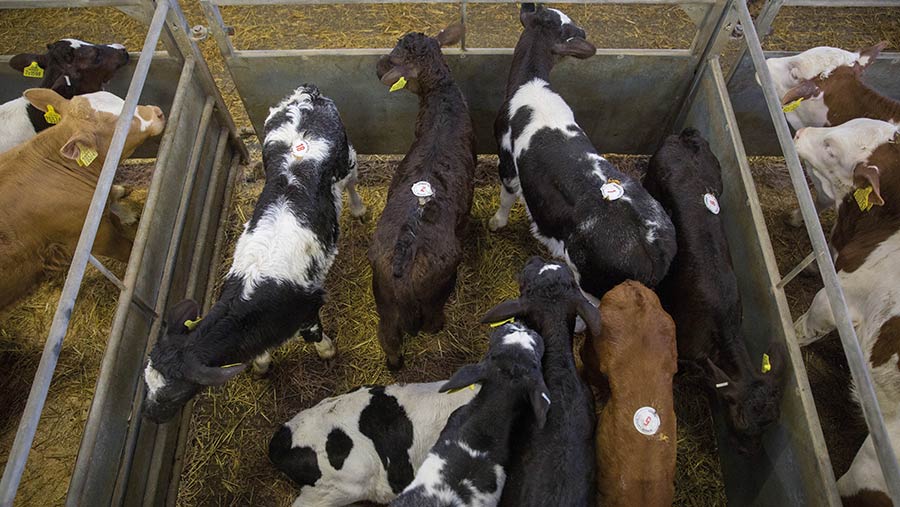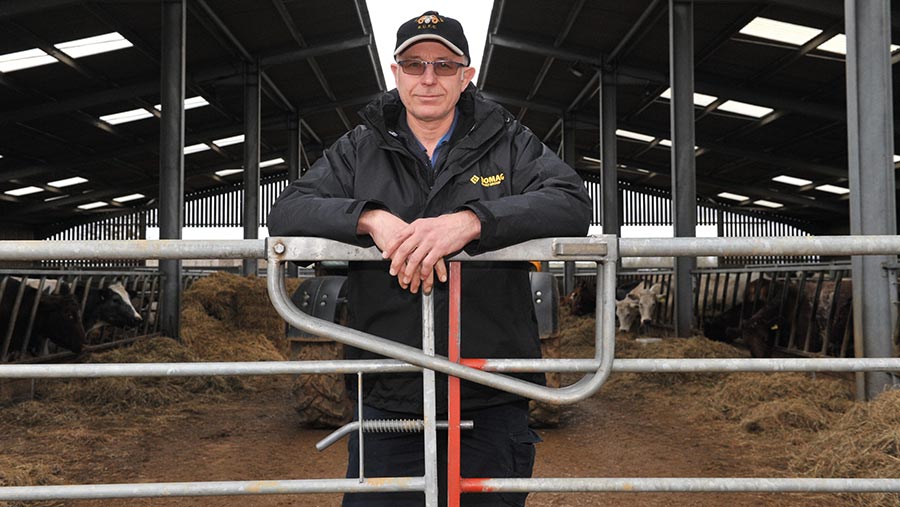Analysis: How livestock auctions fit in today’s meat markets
 © Tim Scrivener
© Tim Scrivener There is a certain nostalgia associated with trading livestock at a live mart – it is, after all, a system that has operated well for more than 200 years.
But livestock farming is a business with tight margins, so it’s not nostalgia that keeps farmers returning to the auction mart week after week.
See also: Read our livestock marketing advice in one place
Livestock Auctioneers’ Association (LAA) secretary Chris Dodds describes it as the fairest method of trading and valuing livestock – an “independent, transparent, open and competitive forum”.
“It is the only marketing system that works for the vendor. Farmers use marts because they feel they are getting true and fair prices for their stock,” says Mr Dodds.
“Back in 2001, when there was no option for live sales because of foot-and-mouth, and again in 2007 when there was a small hiccup in trade, abattoirs paid as little as they could for stock, because they are in business to make money. They want to buy as cheaply as possible.”
It is live sales that have driven prices during the pandemic, he suggests.
“If farmers haven’t realised the value of auction marts in the past 18 months they never will. Prices might not necessarily be the best every single week, but on average they have been at the top of the table through the past 18 months, and continue to be there.
“Although the farmer does not know exactly what he will make for his animals before they are presented for sale, he does have the option of taking them home if the price is not good enough.
“More importantly, there are no deductions made post-sale for the animal being ‘out of spec’, such as overweight, the wrong breed, overage, or having made too many moves in its life.”
The auction ring is where the price is set, Mr Dodds points out. “We only see deadweight prices catching up the following week.”
‘Out of pocket’
There are 122 livestock marts in Great Britain – 72 in England and 25 in both Wales and Scotland.
The liveweight marketing system operates in ways that can be of great benefit to the seller and the buyer, but they are not immune to problems and issues can arise, not least when an operating company fails and farmers are left out of pocket.
But there have been high-profile abattoir failures too, Mr Dodds points out.
“As with any business, there are problems from time to time, but history tells us that farmers have been more protected than not by the auction system.”
Although no new markets have opened in recent years, some that have closed have reopened – Builth Wells mart reopened under a new operator in 2021 and business is booming, says Mr Dodds.
In West Wales, this has also been the case at Llandeilo, where auctioneer Huw Evans has taken over the site following the demise of BJP Marts, and Nock Deighton is in the process of getting the former BJP Marts site at Carmarthen operational again.
Social aspect
Aside from the actual business of buying and selling, livestock marts also provide an important social aspect to farmers’ lives that the deadweight sales route can’t.
A new report commissioned by The Prince’s Countryside Fund and published in 2021 highlighted how auction marts tackle social isolation and improve the health and wellbeing of their users.
Mr Dodds says this report, and others, shows a need for livestock markets over and above simply trading.
“Farming can be a lonely job, a mart gives farmers the chance to get together,” he says.
He suggests that through 2021, deadweight sellers, many of whom had been selling to abattoirs for years, returned with some or all of their cattle and sheep.
Deadweight appeal
The evidence for that is anecdotal because figures for 2021 have yet to be published. But what 2020 data does show is that, while livestock marts took the biggest share of sheep sales at 55%, almost 90% of prime cattle and adult bulls sales were through the deadweight system.
Yes, there has been a contraction in the number of UK abattoirs – in the past three years alone numbers have reduced by 20 to 159 – but those that remain have expanded.
These businesses are highly focused on mainstream retailers and are prescriptive in the consistency of product.
What cannot be disputed is that abattoirs would not be able to operate if marts were their only means of sourcing livestock, says Nick Allen, chief executive of the British Meat Processors’ Association.
“Abattoirs start operating at five or six in the morning, the supply chain couldn’t function if it had to reply on sales of cattle and sheep later in the day.”
Beef producers favour the deadweight system for multiple reasons, Mr Allen suggests, not least for the certainty of what they will be paid for their stock.
“Farmers who sell deadweight prefer to sell straight to the processor, predominantly because they know what they are going to be paid before the animal even leaves the farm.”
‘A gamble’
Selling an animal through a mart is a gamble, Mr Allen believes.
“Sellers don’t know who is going to be at the mart, which buyers are going to be there.”
There is also the commitment of time needed to attend a mart, although the drop-and-go services many auctioneers operated amid Covid restrictions showed that the live mart system could function well without farmers being physically present.
But deadweight sales are still less time-consuming, says Mr Allen.
“A lot of farmers like to be at marts to keep an eye on what is happening and that eats into their day.
“If they are selling deadweight they can arrange to have their stock picked up from the farm, rather than working out how they are going to get them to the market when they may be short of time.”
Feedback
Another advantage of selling on the hook is the feedback on carcass conformation and fat cover on the kill-out sheets.
“Farmers like that feedback and the conversation with the abattoir, it keeps them in touch with what’s happening in the marketplace and further down the supply chain,” says Mr Allen.
Despite making the case for deadweight selling, Mr Allen reckons there is a need for the auction ring too.
“It is not unreasonable to argue that auction marts set the price. That’s why I think there is a place for both deadweight and live sales.
“Marts give the industry a feel for what’s going on, but only an indication of trends rather than what is happening on a particular week.”
Case study 1: Selling liveweight is fair and social

Nicola Pughe © Debbie James
Selling lambs at her local auction mart at Talgarth scores over the deadweight option on several fronts for sheep farmer Nicola Pughe.
As her family’s farm, College Farm, Trefecca, is just a mile from the mart, it is not inconvenient or costly to take the lambs home if she is unhappy with the prices offered, and she enjoys the social aspect of meeting other farmers.
“The economics of transporting the lambs to Talgarth are very favourable,” says Mrs Pughe.
Although she has the option of withdrawing animals from sale if the bid price doesn’t meet expectation, she is confident she receives the best price in the auction ring.
“If it has been a good week in the live marts, we often see abattoirs raising their prices for the following week,” says Mrs Pughe.
But she concedes there is one aspect to deadweight sales that she likes, when she has used that route.
“Having the information on the kill-out sheet is really interesting and helps us understand which animals are hitting the right grades and fat classes.”
What selling direct to slaughter can’t replace, however, is the huge part that marts play in the social fabric of rural life, she reckons.
“They play a massive part in the lives of many farmers. For some it is the only place that they get the opportunity to catch up with neighbours and friends. It would be a massive loss if that disappeared.”
Talgarth Livestock Market is operated by Sunderlands, which took on the running of Builth Wells mart in 2020.
Case study 2: Selling deadweight ensures quality feedback

Richard Spencer © Debbie James
Richard Spencer sells his cattle to Woodheads to supply the Morrisons Shorthorn Beef premium scheme.
There as a number of factors that, when combined, make deadweight his preferred sales route.
“They always treat me very fairly. I sometimes pick out the stock myself, but quite often a fields officer will come out and take a look,” he says.
“I weigh the cattle myself before they go, for peace of mind.’’
Mr Spencer receives the kill-out sheets on the same day the cattle are slaughtered and payment is in his account within six days.
All steers finish at 20-24 months at a deadweight average of 340kg. Fat cover grades of 3 and 4L are targeted, and R and O+ for conformation.
Mr Spencer’s farm at Newbold-on-Stour is at least an hour’s drive from his nearest cattle mart at Rugby, Warwickshire.
“By selling directly, the cattle are collected from the farm, I haven’t got to transport them to a live market where I wouldn’t know the price I would be paid until they are sold.
“I know what the base price is and if I hit the specification I get paid a premium too.”
